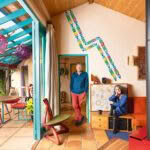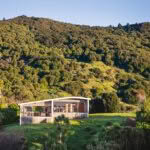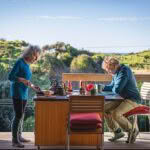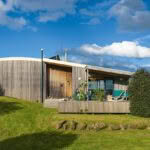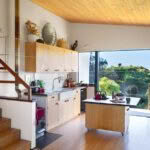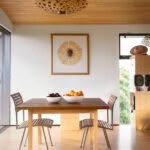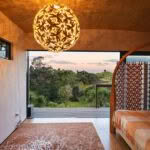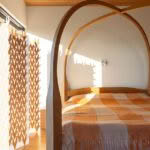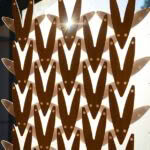Hawke’s Bay designer David Trubridge finds inspiration from Mother Nature herself
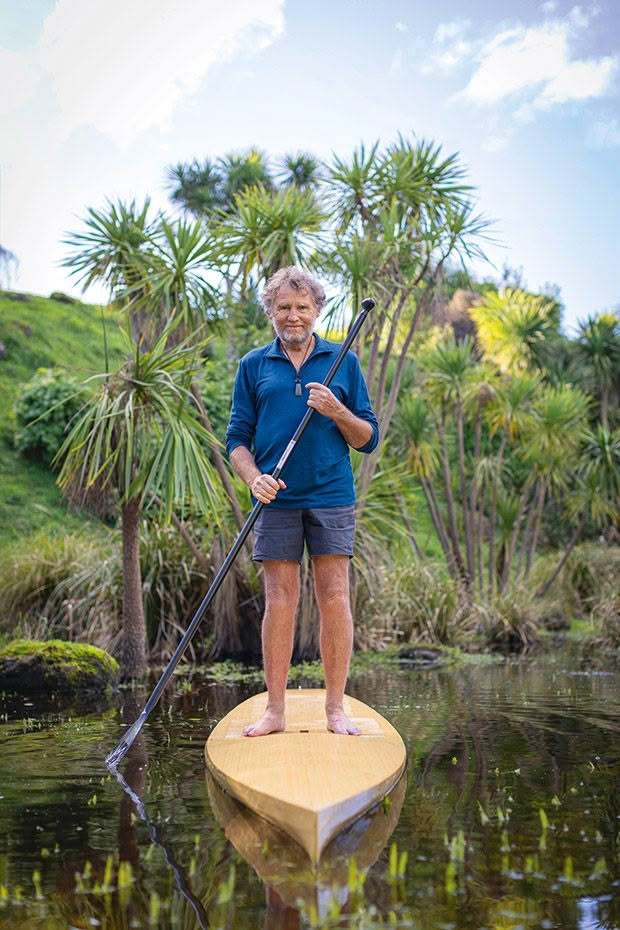
David Trubridge on his handcrafted stand-up paddleboard (SUP) which, on a calm day, he likes to paddle up the coastline from his bach at Māhanga Beach near the Māhia Peninsula. The 15-kilogramme structure, the fourth board he’s made, is constructed from 1.5-millimetre bamboo plywood with an intricate internal honeycomb structure of CNC-cut (computer numerical control) pieces. He built a kitset plywood kayak as a teenager and, lured by his love of boats, ended up studying naval architecture at university.
Many artists spend their entire lives searching for inspiration. But for David Trubridge, the natural world has everything he could need.
Words: Michael Andrew Photos: Tessa Chrisp
It’s hard to imagine where designer David Trubridge would be without the ocean. The Hawke’s Bay-based lighting, furniture, jewelry-maker and author has spent a lifetime rising and falling with its swells, borne by its currents, mesmerized by its immensity. From his childhood on the Isle of Wight to his training in naval architecture in the 1970s to his successful career as a designer of acclaimed pieces with names such as Coral, Body Raft and Sail Chair, almost every aspect of his personal and professional life has been permeated by the ocean’s ceaseless roil.
He knows exactly why it’s so important to him. “It’s the primal quality of the ocean — this one massive sense of energy, of movement. Restless, breathing, living movement all around you that you’re a part of. I can go out on a paddleboard and onto the sea. The energy of that sea has not changed since the first life form emerged. Those waves haven’t stopped coming in that period. It’s utterly timeless. That’s what I love about the ocean: that timelessness and enveloping life.”
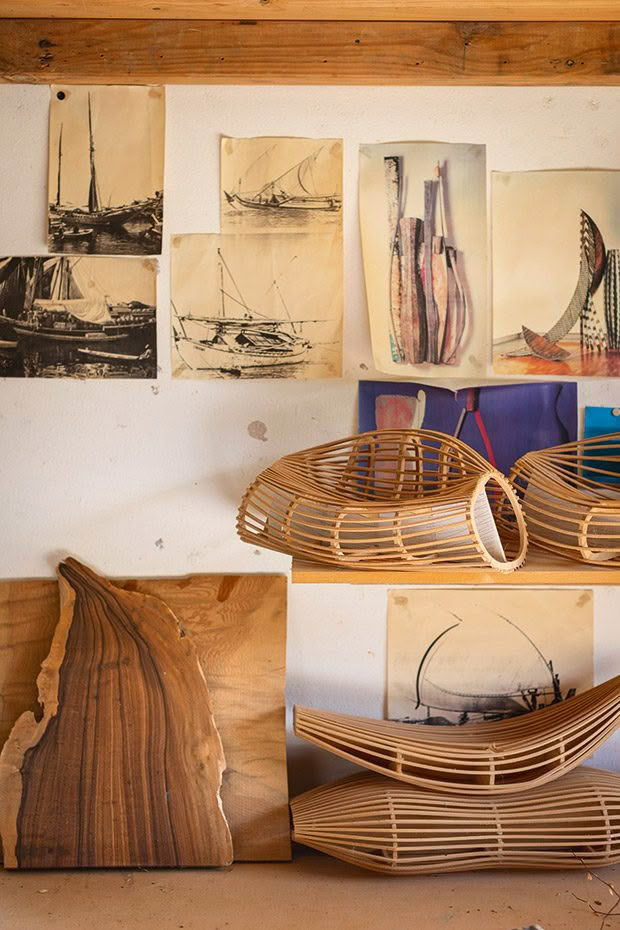
David is well-versed at elucidating his connection to the natural world. His latest book, The Other Way, conveys the poetic reflections of his recent journey to the Earth’s remote, wild and lonely places. Whether exploring the channels of Finland’s Åland Islands by paddleboard or squinting through the deathly white brightness of Antarctica, he uses what he sees and feels to eloquently ruminate on a life spent finding meaning in the detail of natural places.
“That’s the nature of being an artist; finely tuned antennae that pick up what’s going on around you. It’s the wild places — it doesn’t matter if it’s a beach, mountain, or forest. They all excite me.”
A recipient of the New Zealand Order of Merit for services to design, David is one of Aotearoa’s most celebrated designers. With a career spanning almost 40 years, he’s had plenty of time and experience to discover what works for him. But unlike other artists who keep their muses at a distance, his craft was spawned from traversing the very thing that inspires him most — the high seas.
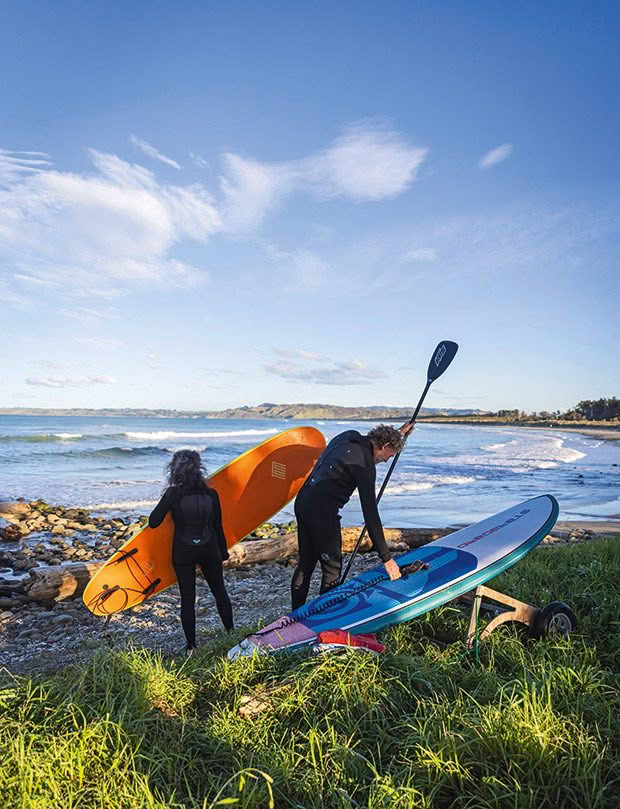
In the early 1980s, he was making furniture in England. But having become disillusioned with Margaret Thatcher’s Tory government, feeling overwhelmed by the threat of nuclear war, and gripped by an urge for adventure, David, his wife Linda and their two boys, Sam and William, departed England for the world on a 14.5-metre steel cutter named Hornpipe.
They would spend the next five years at sea, traveling the globe, navigating by sextant, and living a free and easy sea-vagabond lifestyle beyond the clutches of national bureaucracies. The voyage took them to the Pacific islands, where David drew influence from the local artwork of the seafaring Polynesians and set a new bearing towards what would become his acclaimed Sail Chair design.
In 1985, having spent almost half a decade at sea, the family found themselves in Aotearoa, and set anchor in the Bay of Islands. “At first, we actually didn’t like New Zealand,” David says. “We’d spent five years visiting tropical islands in the Caribbean and the Pacific, doing work here and there, living on the boat and having a wonderful outdoor life. But we suddenly found ourselves back in this extension of the British colonial way of living that we thought we’d left behind. We didn’t want to stay.”
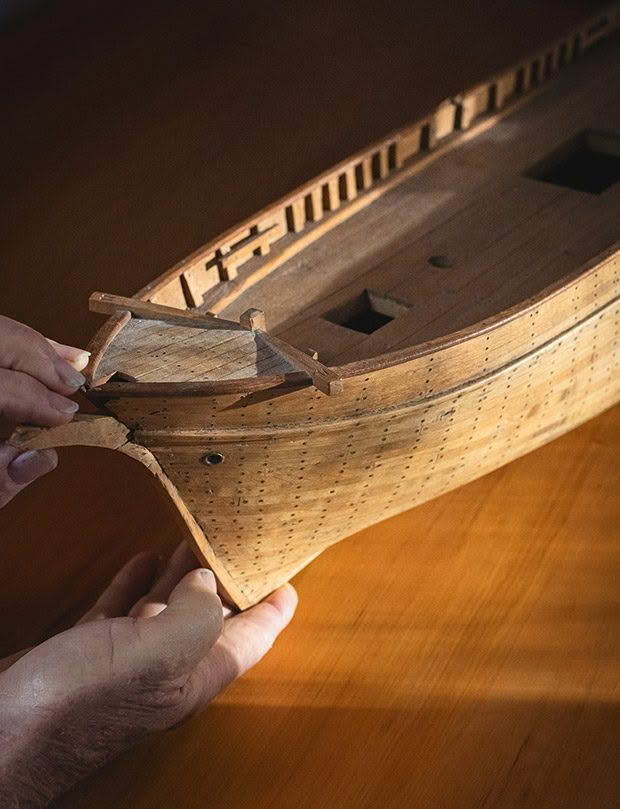
However, New Zealand changed considerably over the next few years, and the family changed with it. They soon saw past the superficial aspects and found a place where they could stay for a while. In 1990, they moved to Hawke’s Bay, where David took a position as an artist-in-residence at the then-Napier Taradale Community College.
While they planned to sail again, David says his boys had put down roots and made friends. “We realized that we’d had our time [at sea], and it was important for them to have a more stable life and spend time with their peers.” He says those 10 years of sailing benefited both boys, for whom the sea was a garden and playground. William is the world’s top freediver, holding 18 world freediving records and is a six-time world champion, and Sam is an artistic director whose work involves directing in unconventional spaces. They decided to sell Hornpipe and build.
While David describes selling the yacht and severing his main link with the ocean as “traumatic”, it was mitigated somewhat by the freedom from constant maintenance that comes with boat ownership. It also allowed him and Linda, also an artist, to own studios for the first time in years.
- In 1992, inspired by the solid English stone houses in which he grew up, David designed the couple’s Hawke’s Bay home. He initially wanted to use rammed earth but settled for locally made concrete blocks, providing solidity and a passive solar heating and cooling effect.
- The home integrates a Mediterranean, adobe-style look with outdoor living spaces and plenty of indoor-outdoor flow.
- David created the coloured murals, and he and Linda deliberately chose “strong, contrasting colours” that create light and joy throughout the house. The style of the house struck a chord with locals, and he was asked to design many more in the region.
Hawke’s Bay became the base of operations for David’s business, which began to flourish in the late 1990s with the design of his Raft Series seats. By combining his naval architecture training — which taught him to draw complex three-dimensional forms — with newly introduced computer programmes, he could channel his maritime artistry into original forms. His career accelerated in 2003 with the creation of the Coral light — a world-first designer pendant inspired by geometric polyhedra. “The crazy thing about the Coral is that it’s still, 20 years later, the best-selling product,” says David. “It was basically the basis of the whole business. So, in that sense, it’s the design I’m most proud of. But as an artistic piece, I think I have more pride in the Body Raft.”
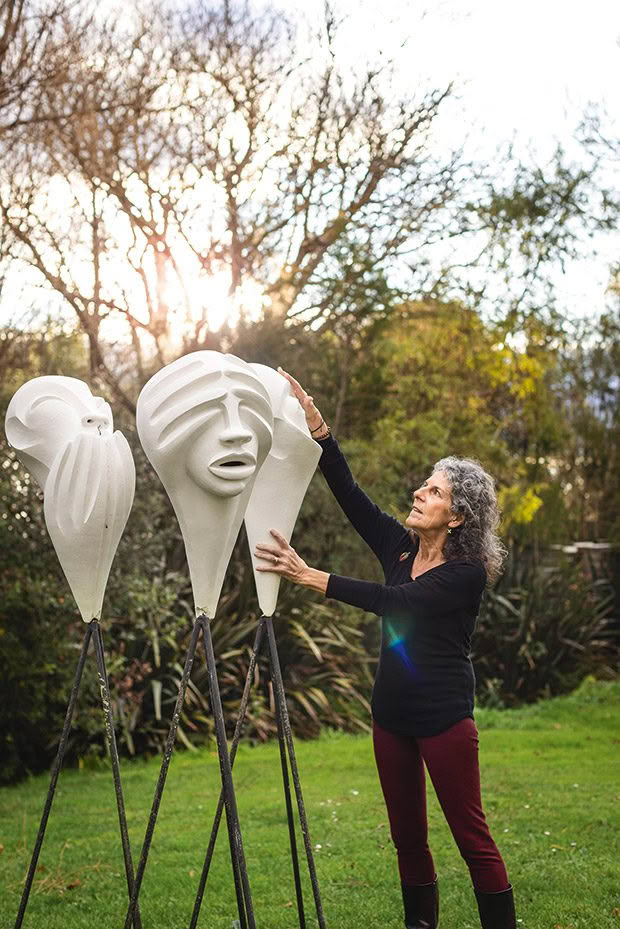
Linda with her ceramic sculpture, No evil —live oN, which is based on the story of the three wise monkeys: see no evil, speak no evil, hear no evil. Linda studied fine art at university in England and creates 2D and 3D artworks. She recently wrote and published a book about the family’s sailing venture called Passages.
A layperson might be forgiven for thinking a designer does not take their work home with them. But David’s creative medley of engineering and art is applied equally to his personal life as it is his work. The family house and their Māhia Peninsula bach are no exceptions. “They’re built 20 years apart, but both are expressions of me and what I believe in. And that really has to do with design principles and values. They’re applied equally, whether a piece of architecture or a silver earring.”
Both dwellings were built in accordance with biophilic design — a way of designing that tries to follow the “bottom up” processes of nature, rather than through the external imposition of traditional western architecture. It involves integrating a structure with the environment to connect the occupant with the outside world. As David says, both buildings have been designed from feeling; from inside out.
- David and Linda’s bach in Māhanga Beach is built on land affected by a massive landslide 2000 years ago. Because the earth is fairly unstable, engineers would only allow driven-pile foundations. Instead of bulldozing a flat platform, David allowed the house to follow the curve of the section.
- The outer cladding reaches down to the grass so that the house sits comfortably on the land, and the roof reflects the flow of the ridgeline behind. The bach is entirely off-grid, with solar power, rainwater tanks and a composting toilet.
The bach is entirely off-grid and built without treated timber or pollutants used widely in the building industry. Perhaps, most importantly, it’s located a quick walk from the boundless reservoir of creative energy: the ocean. “It’s a great area to get out to sea. I go surfing, paddleboarding, windsurfing — and that’s enough for me.”
- The bach’s kitchen island is on wheels. It contains everything needed to cook with and can be rolled out onto decks on either side of the house. The cupboard above the sink hides a drying rack where the dishes are stored out of sight after washing up. A Pyro Classic wood-burning stove heats their water.
- Rather than making a “grand architectural statement”, David says the appeal of the Hawke’s Bay house and the bach lies in many small details. He likens the design process to his photography in The Other Way, which uses semi-abstract images of subtle details to build a story, rather than a grand shot that tries to capture everything and ends up with nothing.
- All the furniture in the house was designed by David and built in his workshop. The wardrobe doors (ne), which allow ventilation to the clothes inside, reflect the same design in the standing screen.
- The bach’s framing and cladding were constructed with untreated, locally grown macrocarpa, as opposed to standard treated radiata pine. Wool insulation is used instead of pink bats.
Although he no longer sails, David regards his family’s ocean voyage with a near-deific reverence — never has he felt so fulfilled, so connected, so at one with the world around him than during those five years at sea.
And yet, the memory of the sailing, he says, is embedded. It doesn’t take much for it to come back out again whenever he walks down from his bach and immerses himself in the seething tide. “I swim out through the surf, the final triumphant cascade of timeless energy,” he writes in The Other Way. “I know this rhythm; I have shared its heartbeat across thousands of miles of oceans.”
“I am different. My heart surges, and my spirit swells. I am refreshed and replenished; sea cleansed.”
AN ACCIDENTAL MASTERPIECE
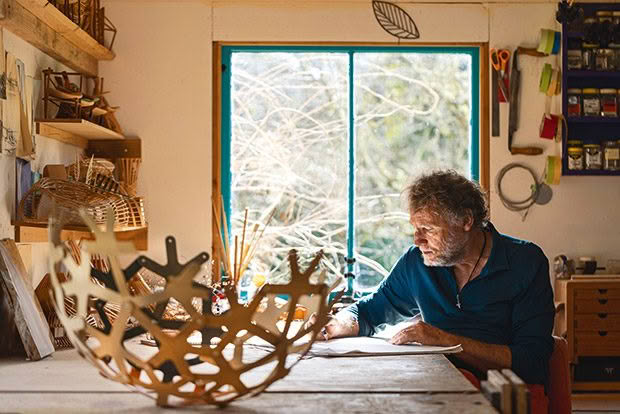
Coral, the flagship design that propelled David’s work to international acclaim and launched a range of other products, continues to be the best-selling product in his portfolio. But it came about somewhat incidentally.
While teaching in Perth in the early 2000s, he had some spare time and decided to play around with a design from his childhood. “I love to make things just for the fun of making them,” he says.
“As a kid, I made these cardboard models of polyhedra — dodecahedrons and icosahedrons. I asked myself whether I could do it with plywood.”
The challenge was that sheet material cannot be bent in more than one direction. A piece of paper will bend this way and that, but it won’t bend over the surface of a sphere. However, by cutting the plywood into a series of fingers radiating in different directions like a splayed hand, each finger could be bent separately and laid over the surface of the sphere.
The model was based on a pentagonal hexecontahedron with 60 identical five-sided faces grouped in 12 sets of five arrays. David turned the vertices (the three-way or five-way points where the lines meet) into the connection points for the ends of the fingers. Because the plywood was too thick and cut inaccurately with a bandsaw, the model broke not long after he made it.
He later did the same thing with thinner plywood and used a highly accurate computer numerical control (CNC) machine, and the model stayed intact. Not knowing what to do with it, David put a light bulb inside at Linda’s suggestion, and a masterpiece was born. davidtrubridge.com
BIOPHILIC DESIGN
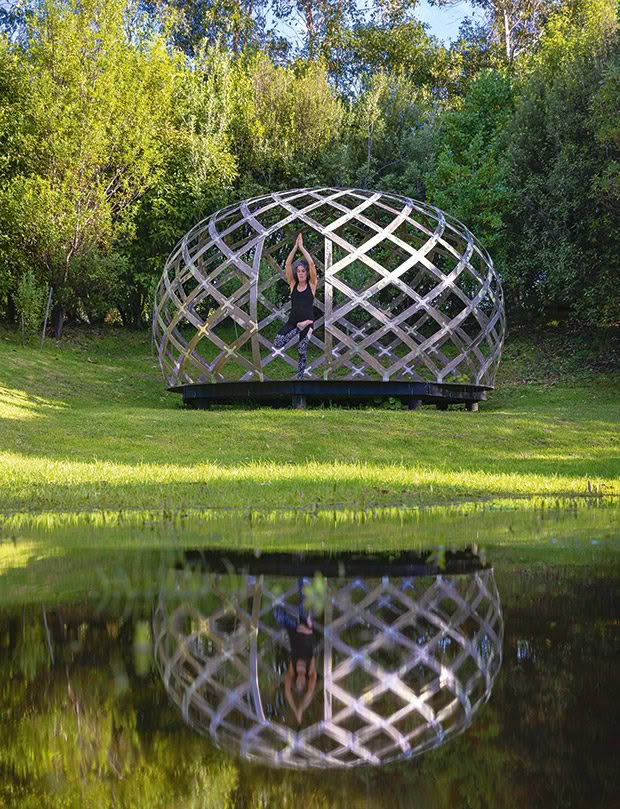
Yoga has been the foundation of Linda’s life and philosophy since she was a teenager. Currently, she teaches yoga in the local prison. Here she does her daily practice in David’s “Dream Space” dome, built as a trial for a new thermally modified pine product. In 2011, he packed the pieces for the entire structure of one of the domes in one suitcase for assembling and exhibiting in Milan.
Much of David’s work is influenced by biophilic design, of which he’s an ardent advocate. An extension of biophilia — an ancient theory that suggests human beings have a natural affinity with living systems and an innate tendency to commune with nature — biophilic design principles aim to foster that connection in the construction of buildings and urban spaces.
By using materials such as wood, utilizing sunlight, creating indoor-outdoor flow and integrating natural curves, colour and vegetation, designers can theoretically create indoor environments that provide occupants with the same wellbeing benefits they would receive in a purely natural landscape. Biophilic design contrasts with traditional western architecture practices, which impose a building on a landscape and seek to shelter occupants from the outside world.
David describes it as “gathering what’s there and enabling it to take form out of the place, the history, the nature, and the people” of the surrounding environment.
Love this story? Subscribe now!
 This article first appeared in NZ Life & Leisure Magazine.
This article first appeared in NZ Life & Leisure Magazine.
